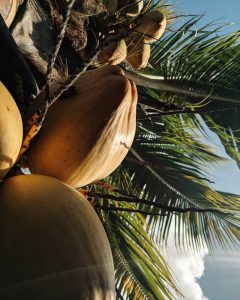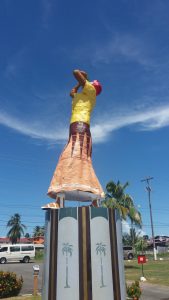COCO, water-nut, the tropical nut–whatever nickname you may call it–coconut is no stranger to Guyanese. No matter where you go in our country, even in the most urbanised parts, you will find coconut trees. Almost every part of the coconut tree is useful.
The branches can be used to make brooms that can be found in every– if not all Guyanese households–and eye-catching craft items. The ‘flesh’ or white inside of the nut can be used to make a dairy substitute for milk that we would use to make mouth-watering cook-up rice, metemgee, sugarcake, fat top, etc. We can also make coconut flour from the flesh.

Everyone’s favourite is perhaps the water that the young nut produces. It certainly is my favourite drink! Coconut oil is not only used for cooking, but can also be used in your hair and skin-care routines. Not only can the leaves be made into craft items, but the hard shells of old nuts as well. Bowls, ornaments, fridge magnets and keychains are just a few items that locals make out of the shell. Its use is not as popular, but the coconut husk of old nuts can also be made into rope and also scrubbers for showering.
Have you ever seen the Umana Yana? While its roof is made of palm branches, the same can be done with coconut branches as well. The dried branches of the coconut tree can be skilfully put together to make thatched roofs. Even the flower is used to make traditional medicines and the wood ‘catches’ a nice fire for your outside fireside set-up.

In the most cliché ways, people all over the world associate coconuts with the Caribbean and I have been trying to find a deeper link. Maybe, the versatility of the plant and its many uses, reflect the collective culture of the Region’s people as well. From the implementation of the ‘Coconut industry development in the Caribbean’ in the nine CARIFORUM countries, an initiative under CARDI and International Trade Centre, to the Coconut Festival hosted in Guyana and the unveiled Lady Coco statue are examples of the investment Guyana and the Caribbean currently places on the industry. The growing numbers of coconut estates and exportation/local sales of coconut-related products are examples of why we should appreciate and encourage more investments.
While there may not be a national fruit, the ‘riches’ we receive from this plant says otherwise. After the fall of most sugar estates, Guyana had a ‘coconut epiphany.’ If you travel across the country, you will find many private land owners planting dwarf coconut trees, perhaps to catch up with the time and realisation that there is so much more to this tree than meets the eye. I encourage you all the support local businesses with coconut initiatives and encourage the conversation of its wide usage. Guyanese tend to overlook the coconut tree, but next time you see coconut confectioneries, soaps, oils or even when enjoying your cook-up rice—know it is from Guyana’s very own tree of life — the coconut tree.



.jpg)











